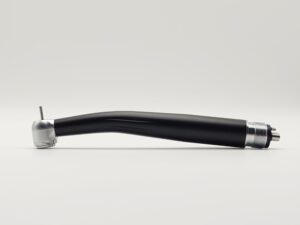In the field of modern dentistry, dental handpieces play a crucial role. They are essential tools that dentists rely on to perform a wide range of procedures with precision and efficiency.

Dental handpieces can be classified into different types. The high – speed handpiece is one of the most commonly used. It rotates at an extremely high speed, usually up to 200,000 – 400,000 revolutions per minute. This high – speed rotation enables dentists to quickly and accurately cut through tooth enamel and dentin during procedures like cavity preparation. The low – speed handpiece, on the other hand, rotates at a much slower rate, typically in the range of 10,000 – 30,000 revolutions per minute. It is often used for more delicate tasks such as polishing teeth, removing soft decay, or placing dental materials.
The working principle of a dental handpiece is based on air – turbine technology or electric – motor technology. In air – turbine handpieces, compressed air is used to drive a small turbine, which in turn rotates the dental bur. The fast – moving air causes the turbine blades to spin, transferring the rotational motion to the bur. Electric – motor handpieces, as the name implies, use an electric motor to power the rotation. These handpieces offer advantages such as more precise speed control and better torque at low speeds.
Maintenance of dental handpieces is of utmost importance. Regular cleaning is necessary to remove debris, saliva, and blood that accumulate during procedures. After each use, the handpiece should be thoroughly cleaned both inside and out. Lubrication is another key aspect. Proper lubrication ensures smooth operation of the moving parts, reduces wear and tear, and extends the lifespan of the handpiece. Additionally, sterilization is crucial to prevent cross – contamination between patients. Dental handpieces must be sterilized using appropriate methods, such as autoclaving, before each use.
In conclusion, dental handpieces are indispensable in dental practice. Their proper use, understanding of different types, and regular maintenance are essential for providing high – quality dental care. As technology continues to advance, dental handpieces are likely to become even more efficient and user – friendly, further improving the dental treatment experience for both dentists and patients.

